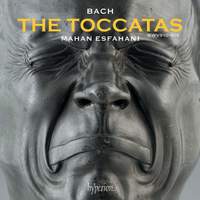Interview,
Mahan Esfahani on Bach's Toccatas
 Any new release from Mahan Esfahani is worth sitting up and taking notice of - he's an artist not afraid of exploring projects far from the beaten track, and even his recordings of mainstream repertoire can be relied on to be insightful and thought-provoking. His latest album comprises the set of seven toccatas for keyboard by JS Bach, BWV910-916, and draws on the expanded sonic palette of an instrument offering two additional octaves for a bold, rich sound that's perfect for these dramatic, colourful works.
Any new release from Mahan Esfahani is worth sitting up and taking notice of - he's an artist not afraid of exploring projects far from the beaten track, and even his recordings of mainstream repertoire can be relied on to be insightful and thought-provoking. His latest album comprises the set of seven toccatas for keyboard by JS Bach, BWV910-916, and draws on the expanded sonic palette of an instrument offering two additional octaves for a bold, rich sound that's perfect for these dramatic, colourful works.
I spoke to Mahan about how he approached performing these toccatas, from producing his own editions to decisions about how to deploy the different sounds available to him.
These are, as you say in your notes, mystifying works, due partly to the way they invite an element of “completion” by the performer. Do you find this requires a different approach in performance to other works, that we might regard more as finished articles set in stone?
Or perhaps they’d shed light on the character of works that we regard as ‘finished’ but which might also benefit from the participation of the performer. Just to be clear - I don’t believe that this is a matter of pure artistic self-absorption and interference (namely what I’m doing in this recording). Rather, as I argue in the notes, there are elements of the scores and the extant material which justify my approach to these pieces. Nothing that I’ve done is not justified by the notation - nothing. But the mid-century early music hoax that ‘less expression is more authentic’ has pretty much died by now. Thank goodness for that.
You mention your frustration with the extant published versions of these toccatas – to the extent of having made your own from which to perform. Do you find that this approach, delving into the innards of each toccata in minute detail, affects the way you play them?
Well, I think it’s important to remember that the people who copied out these sources (whether the composer himself or his followers) also played them, so it’s fruitless to speak of ‘period performance’ - which in our time is mostly an assortment of homogenised tricks pasted onto the music in order to seem proper and authentic - without understanding the period conception of music as viewing composition, copying, improvisation, and performance as inextricable parts of the same discipline. The more you look at the tension between the sources, the more you have an idea of what the physical intent was of each notated gesture.
One thing that really stands out about this recording is your use of the 16’ stop on Jukka Ollikka’s instrument, which creates an absolutely magnificent sonority at key moments. Are registration changes ever specified by composers, or is it for the performer to decide what rhetorical approach to take?
There are the occasional indications from this and that composer - not only Bach. But of course it involves guesswork, the occasional act of archaeology, and some artistic responsibility to decide what to do. I think it’s important to keep in mind that I always believe my interpretation of a piece in question is basically one solution of many to a notation we will never completely understand. It’s never meant to foreclose on other interpretations - including those on the piano!
You also have a 4’ stop at your disposal, allowing for key passages to be doubled at the octave both above and below – an almost overwhelming sound. Did you find yourself having to adopt elements of an organist’s technique in terms of working stop-changes into your playing?
Insofar as there would be any elements of organ technique not directly related to good harpsichord technique (or good piano technique, for that matter, in a larger sense), I don’t think that’s really the right question. There is no evidence that harpsichordists cultivated the art of registration any less - or let’s say, any differently - than the manner practised by organists. This is a good question, though. Not enough people note the connections between instruments here, and of course Bach had a special relationship to another instrument seldom mentioned: the clavichord, an instrument with deeply affecting dynamic range that I quite enjoy playing any evening when I’m home.
The F X Messerschmidt character head from the late eighteenth century that adorns the cover art, looking for all the world like a man who’s just eaten a lemon, is undeniably a striking design; what’s the significance of choosing such an unorthodox image to front this album?
What’s an orthodox image for an album? - it sounds like a frighteningly dull prospect. I thought that it would be great to have a visual concept to the entire Bach Project for Hyperion - we will be recording everything, fingers crossed! So, I saw the Messerschmidt heads (there are quite a few) at the Belvedere in Vienna a year or so ago, and I thought they’d be a good way of unifying the entire series, a way for people to recognise all the albums over time. The element of shock in this particular head relates well, I think, to the nature of the toccatas.
Mahan Esfahani (harpsichord)
Available Formats: CD, MP3, FLAC, Hi-Res FLAC



